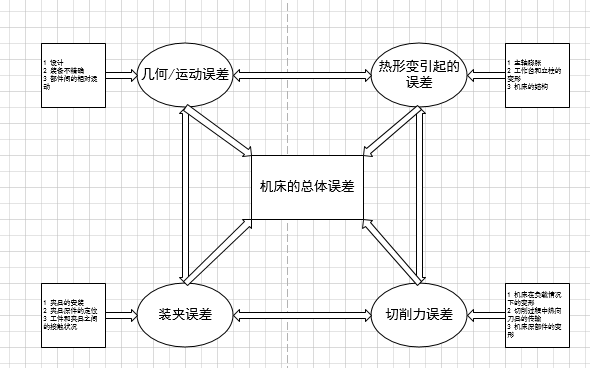基于DSP的线性回归预测模型设计与实现毕业论文
2021-03-13 22:52:22
摘 要
数控机床在加工过程中,受各种外界环境的影响,不可避免的会产生各种误差。对于精密数控机床,造成误差最大的是热误差,研究表明热误差占总误差的50% ~80%。因此研究、分析、预测数控机床的热误差具有重要意义。本文借助DSP软件,进行相应的线性回归预测模型设计,预测数控机床的热误差。
本文主要研究了三轴数控机床在室温环境下,不同轴随室温变化产生的具体热漂移热误差,并通过建模分析不同测温点对热误差的贡献以及对温度的敏感程度,并对热误差进行预测分析。
研究结果表明,Y轴和Z轴对于温度的变化产生的热误差较小,而X轴则是数控机床热误差的主要来源。通过建立的模型分析,实际的热误差与预测热误差基本吻合,说明线性回归模型的效果比较好。
本文的特色在于利用了灰色系统理论,进行测温点的选择,这样构建的模型可以更好地预测数控机床热误差
关键词:数控机床;热误差;线性回归;灰色系统
Abstract
During the processing process of CNC machine,the CNC machine will be affected by various external environment condition ,as a result ,inevitably generate a variety of errors. As for the precise CNC machine tools,the biggest error of machine is the thermal error. According to the study,,it can reach almost 50%to 80% of the overall error. So,it is of vital importance to analyze the thermal error of CNC machine. In this paper,with the help of DSP software,we will design a linear regression model to predict the thermal error of CNC machine.
We focused on the three-axis CNC machine’s thermal error in room temperature environment in this paper. We will also analyze the contribution of different temperature points to thermal error ,what’s more, thermal error sensitivity to temperature..
The results show that the thermal error of the Y-axis and Z-axis is small than the X-axis,affected by the change of temperature. We can learn that the X-axis is the main source of the thermal error of the CNC machine .Through the analysis of established linear regression model, we can know that the actual thermal error and thermal error prediction are consistent, indicating that the linear regression model is well.
The characteristic of this paper is the using of gray system theory,with which to choose the temperature measurement points. As a result ,it will be better to predict the thermal error of CNC machine.
Key Words: CNC machine; thermal error; linear regression; gray system
目 录
摘 要 I
Abstract II
1 绪论 1
1.1 研究目的 1
1.2 国内外技术发展现状 2
1.3 论文内容安排 3
2 基于DSP的多元线性回归系统的研究 5
2.1 基于灰色系统理论的数据研究 5
2.1.1 灰色关联分析理论基础 5
2.1.2 基于初值像的灰色关联系数计算 7
2.2 基于最小二乘法的线性回归预测研究 8
2.2.1 回归模型概述 8
2.2.2 基于最小二乘法求解回归系数 10
2.3 DSP的功能及相关开发环境简述 11
2.3.1 DSP结构与功能简介 11
2.3.2 CCS开发平台的搭建与介绍 12
3 数控机床热误差的线性回归建模 15
3.1 引言 15
3.2 基于灰色系统理论的数据选择 15
3.3 基于线性回归的热误差建模研究 16
4 热误差预测模型在DSP上的实验验证 20
4.1 热误差线性回归预测模型的验证 20
4.2 实验结果与结论 21
5 总结与展望 26
5.1 工作总结 26
5.2 工作展望 26
参考文献 27
附录A 28
附录B 35
致 谢 36
1 绪论
1.1 研究目的
随着现代科学技术的发展,各种工艺水平不断提高,人们对于现代机械制造业有了更加严格的要求,高精度和超高精度加工成为现代机械加工业的主流方向。数控机床是人们在日常机械生产中最主要的设备,其加工精度最终决定产品的质量,不断提高机床的加工精度能极大的推动工业化的进程。在现代技术条件下,影响数控机床的加工精确度的原因来自以下几个方面:(1)机床由于热变形产生的误差;(2)机床零部件及其结构的几何误差和装配误差;(3)机床本身重量及负载所造成的变形误差;(4)其他误差源造成的误差。尤其是进入二十一世纪以来,热误差已经成为影响精密仪器加工准确性的最主要因素,众多研究结果表明,热误差占精密占数控机床加工过程产生的总误差的50%~80%。因此建立热误差预测模型,更好的预测热误差量以及有效避免热误差的产生对于数控机床的加工具有什么重要的意义。

图1.1 数控机床常见误差图




